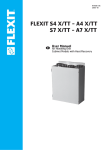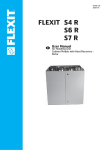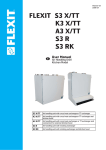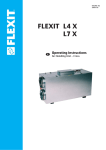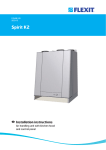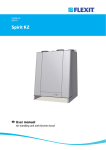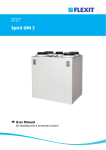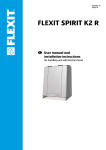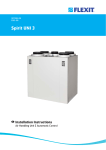Download User Manual FLEXIT L4 X/TT L7 X/TT
Transcript
94122E-05 2005-10 FLEXIT L4 X/TT L7 X/TT User Manual Air Handling Unit Loft Models with Heat Recovery Contents 1 2 3 4 5 6 7 8 9 10 Important Safety Instructions .................................................. 3 Method of Operation - System ................................................. 3 Operation - Control ....................................................................4 Troubleshooting .........................................................................5 Cleaning - Maintenance ............................................................5 Overview Drawings.................................................................... 7 6.1 Overview Drawing, L4 X/L4 X TT ................................... 7 6.2 Overview Drawing, L7 X/L7 X TT .................................. 7 Technical Data ...........................................................................8 7.1 Technical Data, L4 X/L4 X TT .........................................8 7.2 Technical Data, L7 X/L7 X TT.........................................8 Physical Dimensions ..................................................................9 8.1 Dimensioned Drawings, L4 X/L4 X TT ...........................9 8.2 Dimensioned Drawings, L7 X/L7 X TT...........................9 Unit Adjustment Options ......................................................... 10 9.1 Adjustment ................................................................... 10 9.2 Control Card Adjustment Options ............................... 10 CE Declaration of Conformity...................................................11 Symbols Used This product has a number of symbols that are used to label the product itself and in the installation and user documentation. Here is an explanation of some of the commonest symbols. DANGER! ELECTRICITY DANGER! DO NOT TOUCH SUPPLY AIR EXTRACT AIR EXHAUST AIR OUTDOOR AIR HEATING THERMOSTAT EXCHANGER/SUMMER CASSETTE Symbols for units/electric heating TRANSFORMER ADJUSTMENT SUPPLY AIR STAGE 2 TRANSFORMER ADJUSTMENT EXTRACT AIR STAGE 2 Our products are subject to continuous development and we therefore reserve the right to make changes. We also disclaim liability for any printing errors that may occur. 2 System Drawing 1 Important Safety Instructions To reduce the risk of fire, electric shock or injury, read all the safety instructions and warning texts Extract air before using the unit. This unit is only designed to handle F10 F20 ventilation air in buildings. B1 It must not be used to extract combustible or flammable gases. Supply air EB1 Remove the power plug before commencing any service and maintenance work. B1 Before you open the door, the unit must be dead and B6 the fans must be given time to stop (min. 2 minutes). EB1 The unit contains heating elements that must not be EB2 touched when they are hot. F10/F11 F20/F21 The unit must not be operated without the filters being FI1 in place. FI2 Follow the user manual precisely. HR-X P1 ! • • • • • • • M1 M2 To maintain a good indoor climate, comply with regulations and avoid condensation damage, the unit must never be stopped apart from during service/maintenance or in connection with an accident. F11 F21 FI2 Outdoor air FI1 HR-X B6 EB2 M1 M2 Exhaust air SUPPLY AIR TEMPERATURE SENSOR THERMOGUARD HEATING ELEMENT PREHEATING ELEMENT OVERHEATING THERMOSTATS OVERHEATING THERMOSTATS SUPPLY AIR FILTER EXTRACT AIR FILTER CROSS EXCHANGER SUPPLY AIR FAN EXTRACT AIR FAN Frost Protection The unit is fitted with a special thermoguard for maximum utilisation of the heat recovery function and maintenance of balanced ventilation. The thermoguard has a sensor rod B6 with a dual function. This is located in the exchanger cassette’s extract air duct and has an NTC element to check the temperature and an indicator to register condensation water. If the extract air is dry, the thermoguard will ensure that the unit works normally down to an outdoor temperature of approximately -15°C. At lower temperatures, it will produce an impulse to activate the frost protection function. This function will be repeated periodically until the exchanger cassette’s temperature is sufficient to prevent freezing. If the extract air is damp, this function will start at an outdoor temperature of approximately - 8°C. The frost protection function operates as follows: - The preheating element EB2 is activated. - When this does not produce sufficient frost protection, the speed of the supply air fan M1 is reduced. 2 Functional Description In the cross exchanger HR-X, the cold outdoor air and the warm extract air “cross” each other without coming into direct contact with each other. With this principle, 60-70% of the heat in the extract air will be transferred to the supply air. In addition, a thermostat-controlled heating element EB1 will ensure that the supply air has the desired temperature. This supply air is passed via ducts and valves to living rooms and bedrooms. The extract air is extracted either from the same room or via door gaps/overflow gratings to toilets and wet rooms. The used air is passed via a duct system back to the unit, emits heat as stated above and is blown out of the building via a roof hat or wall grating. Heating Elements The heating elements are protected against overheating by overheating thermostats F20/F21, which switch off at 65°C. As an additional safety measure, overheating thermostats F10/F11 switch off at 80°C. The overheating thermostats can be reset manually by pressing the white button. They are located at the front on the top of the unit. They are accessible by opening the doors and removing the plastic cover that covers the access opening. See the label - RESET. The reset button is located on the innermost panel a little way inside the opening. This is purely a ventilation system and not a heating system. The home must be heated in the normal manner. The heat gained from heat recovery must be seen in relation to a situation in which the extract air is blown right out of the home without recovery. 3 3 Operation - Control The speed of the fans in the unit is controlled from a separately mounted SP30 control switch. Depending on the operating situation, the fan speed is set to the desired level. Red Green Yellow MIN stage: Used when less ventilation than normal is required. NORMAL stage: Normal operating ventilation. This is the position for daily operation. MAX stage: Used when increased ventilation is required in wet rooms or throughout the flat. Must be used during and for a while after showering and clothes drying, for example, to avoid condensation in the ducts. If the unit is in temporary automatic frost protection mode in the winter, the unit will not react to a change in speed before the frost protection function has ceased. If there is a power cut, the until will automatically be set to Normal position and with active heating when it restarts. This means that the heating element will heat if there is a need for heating. SP30 Control Switch for Electronic Automatic Control with a Thermoguard This contains the following functions: - Right pressure switch (fan symbol) to choose between min, normal and max speeds with an indicator lamp to show which speed stage is active. - Left pressure switch (+ symbol) to choose heating OFF/ON. This switch is used to switch heating off/on (disconnected during the warm part of the year). The heating thermostat (item 4/Chap. 6 - see label on page 2) is factory-set to 20°C in the unit. It is located outside the unit (on the top of the unit) and should not be set to over 25°C. It can be adjusted with a flat screwdriver. The sensor for the thermostat is located in the supply air duct. Some heat loss up to the valves must be expected where ducts pass through a cold environment. - Red lamp (!): Slow flash: Filter must be replaced (provided that a pressure guard is installed). Fast flash: Overheating thermostat triggered or thermoguard not connected. Permanently on: Both errors - Green lamp (+): This lights when the heating switch is in the ON position. - Yellow lamp (°C): This lights when the heating is active (the element is heating). 4 4 Troubleshooting FAULT DO THE FOLLOWING If the fans are not working or cannot be adjusted • Check that the power plug is correctly inserted in the power point. • Check that the fuses in the electrical cabinet are switched on. • The overheating thermostat(s) (item nos. 7, 8/ Chap. 6 General Drawings) may have been triggered. Remove the white plastic cover and press in the white reset button. • Check that the thermoguard (item no. 3) is connected. If the supply air feels too cold • Check that the heating switch is on and a summer cassette is not loaded. • The heating thermostat (item no. 4) can be set to a higher temperature. • Check that the thermoguard (item no. 3) is connected. • The overheating thermostat(s) (item nos. 7, 8) may have been triggered. Remove the white plastic cover and press in the white reset button. • Check that the heating switch is activated If the air flow rate has been seriously reduced • The filters (item nos. 1, 2) may be clogged by dirt. Clean or replace them. See under “Cleaning - Maintenance” below. • The grille in the outdoor air cap may be clogged. See under “Cleaning - Maintenance”. If none of this helps, please contact your supplier for service. Please state the serial number on the rating plate inside the unit (open the door). 5 Cleaning - Maintenance Before opening the door of the heat recovery system or carrying out maintenance on the kitchen hood: switch off the heat, let the fans continue for three minutes to remove hot air, remove the power from the unit and wait 2 minutes before opening the doors. Doors: Opened by loosening both eccentric hooks and releasing the hooks. The doors can then be completely removed. Fans: Item nos. 9 and 10/Chap. 6. General Drawings. The fans normally do not need to be inspected. If necessary, they can be cleaned with a small brush and compressed air, if possible. NB! Do not use water. Disassemble the fans as follows: L4: Pull out the quick-release contacts. The fan with the visible quick-release contact is loosened by unscrewing the 4 screws in the round motor plate and carefully pulling the motor out of the motor housing. For the fan with the visible intake opening, the screw for the rail in the side wall must be removed and the rail pushed down as far as possible. The entire fan housing can then be released and turned around. The fan can then be released with 4 screws, like the first fan. L7: The fan with the visible quick-release contact is loosened by unscrewing the 3 screws in the end of the fan housing and carefully pulling the fan out. For the fan on which the screws are on the opposite side, the entire fan housing must be loosened by unscrewing the mounting rails (2 screws) on each side of the fan, thus releasing it. The fan can then be released with 3 screws, like the first fan. The fan can be disassembled most easily if the exchanger cassette is removed first. 5 Filters: To preserve a healthy indoor environment, it is important to change filters when they are dirty. Dirty filters lead to: Increased air resistance in the filter – less air in the home – the risk of bacterial growth in the filter – in the worst case scenario, the system can be damaged. How often the filters need to be changed depends on the degree of contamination of the air where they are installed. In general, the filters need to be changed once a year, preferably in the autumn (after the pollen season). In areas with a lot of dust and contamination, the filters should be changed in the spring and autumn. The supply air filter that cleans the outdoor air (2) consists of a prefilter (EU-3 coarse filter) and a compact filter (EU-7 fine filter). Remember the sequence from outside: steel grille – prefilter – compact filter. The supply air filter is a bag filter on the L7. The filters are pushed in place in the fixing rails. The extract air filter that cleans the extract air (1) is an EU-3 filter (coarse filter) and is located on a separate rail. It is recommended that you order a filter subscription to ensure full benefit from the system and the cheapest prices. Order no. for a complete set of filters: L4 X/TT- 12318, L7 X/TT - 12313 Loft model filter location Thermoguard Extract air filter: Flat filter with cardboard frame Supply air ilter: Prefilter and compact filter Cross exchanger Exchanger cassette: Should be checked roughly once a year for dust and dirt in the air ducts. First remove the thermoguard (3) and carefully pull the cross exchanger (11) out. If cleaning is required, place it in a bowl with warm soapy water (NB! not soda) and finally flush it through with warm water. Clean the thermoguard separately with a dry cloth. When removing/installing the exchanger cassette, it is important to ensure that both the cassette and the sensor rod are located correctly and that the cable plug is inserted in the contact. The thermoguard must be located 6 cm from the top of the exchanger cassette and in the centre of the exchanger cassette. Located on the side facing the extract air filter. Valves and duct system: Outdoor air intake: Roof hat: The valves should be cleaned at least once a year. The duct system should be cleaned at least every 10 years. Check once a year that the grille is not clogged with leaves, dust and dirt. Check once a year that the drainage gap at the bottom is not clogged with leaves. This applies only if the system has a roof hat. Summer operation: During the warm part of the year (outside the heating season), there is no need to recover heat. The exchanger cassette can be replaced with a summer cassette that is available as an accessory. This is pushed into place where the cross exchanger (11) is located. This allows the outdoor air to enter the building directly without heat recovery taking place. The thermoguard (3) must then be transferred to the summer cassette. Its location is shown on the label. NB! At the same time, the heating must be switched off (press the left switch (+) on the control panel so that the green light goes out) to avoid the heating element switching on unnecessarily. Remember to reverse this again in the autumn. Drainage: At the base of the unit there is a condensation water drain (14) that conducts condensation water to the waste water drain. It is important that this drain is always open, in good condition and well insulated where it is exposed to frost. It is also recommended that you keep an eye on the drainage system to avoid any leaks occurring. ! Lack of cleaning as prescribed will increase the risk of fire in the event of an accident. 6 6 Overview Drawings 6.1 Overview Drawing, L4 X/L4 X TT Outdoor air 5 7 2 4 13 3 1 12 Extract air 11 8 Exhaust air Supply air Item Part no. 1 G3 extract air filter 2 G3 + F7 supply air filter 3 Thermoguard 4 Heating adjustment 5 Preheater 6 Heating battery 7 Overheating thermostat, preheating 8 Overheating thermostat, heating 9 Supply air fan 10 Extract air fan 11 Cross exchanger, L4/TT 12 Control switch 13 Control unit 14 Drainage outlet 14 10 11 9 6 6.2 Overview Drawing, L7 X/L7 X TT 11 12 3 2 4 6 Item Part no. 1 G3 extract air filter 5 2 F7 supply air filter 3 Thermoguard Outdoor air 4 Heating adjustment 5 Preheating battery 6 Overheating thermostat, preheating 7 Overheating thermostat, heating Exhaust air 8 Supply air fan 9 Extract air fan 10 Cross exchanger, L7/TT 11 Control switch 12 Control unit 13 Drainage outlet Extract air 1 8 Supply air 6 8 7 10 13 9 7 7 Technical Data 7.1 Technical Data, L4 X/L4 X TT Rated voltage Fuse Rated current, total Rated power, total Rated preheating power Rated power, fans Rated power, electric batteries Fan type Fan motor control Max. fan speed Standard automatic control Filter type (SUP/EXTR) Filter dimensions, SUP (WxHxD) Filter dimensions, EXTR (WxHxD) Weight Duct connection Height Width Depth L4 X 230 V/50 Hz 10 A 8.7 A 1980 W 975 W 2 x 165 W 1650 W F-wheel Transformer 2230 RPM SP30 F7/G3 255x220x50 mm 255x220x20 mm 36 kg Dia. 160 mm 605 mm 1000 mm 350 mm L4 TT X TT 230 V/50 Hz 10 A 8.7 A 1980 W 975 W 2 x 165 W 1650 W F-wheel Transformer 2230 RPM SP30 F7/G3 25x220x50 mm 25x220x20 mm 41 kg Dia. 160 mm 605 mm 1000 mm 350 mm 7.2 Technical Data, L7 X/L7 X TT Rated voltage Fuse Rated current, total Rated power, total Rated power, electric battery Rated power, fans Rated preheating power Fan type Fan motor control Max. fan speed Standard automatic control Filter type (SUP/EXTR) Filter dimensions, SUP (WxHxD) Filter dimensions, EXTR (WxHxD) Weight Duct connection Height Width Depth L7 X 230 V/50 Hz 16 A 10.7 A 2460 W 2000 W 2 x 230 W 1000 W F-wheel Transformer 2120 RPM SP30 F7/G3 394x223x250 mm L7 X TT 230 V/50 Hz 16 A 10.7 A 2460 W 1000 W 2 x 230 W 2000 W F-wheel Transformer 2120 RPM SP30 F7/G3 394x223x250 mm 394x223x20 mm 394x223x20 mm 66 kg Dia. 250 mm 625 mm 1170 mm 465 mm 72 kg Dia. 250 mm 625 mm 1170 mm 465 mm 8 8 Physical Dimensions 8.1 Dimensioned Drawings, L4 X/L4 X TT All dimensions in mm 8.2 Dimensioned Drawings, L7 X/L7 X TT All dimensions in mm 9 9 Unit Adjustment Options ! 9.1 Before opening the door of the heat recovery system or carrying out maintenance on the kitchen hood: switch off the heat, let the fans continue for three minutes to remove hot air, remove the power from the unit and wait 2 minutes before opening the doors. Adjustment The speed of the unit at the normal stage must be set to the voltage specified in the “Documentation of Ventilation Data” form that is enclosed with the ventilation drawings from the company responsible for project planning. Open the door and unscrew and remove the cover of the automatic control compartment. The transformer is then visible and the cables marked 1 2 3 (as shown on page 2) can be switched over to the specified voltage level. L4 X / L7 X: The automatic control compartment is on the top of the unit. Factory setting Extract air 150 V Supply air 170 V 9.2 Control Card Adjustment Options Dipswitch Cross unit control card Dipswitch no. OFF ON 1 Heating is not affected with frost protection Heating is switched off with frost protection 2 Heating and preheating function normally Heating and preheating are switched off at the min stage 3 Not affected with night-time temperature reduction Temperature is reduced by 3°C with night-time temperature reduction 4 Not affected with nighttime temperature reduction Fan speed is reduced to low with nighttime temperature reduction 5 Preheating element is used only for frost protection Preheating element is also used for heating 6 Must be in this position Not used Bold type shows the standard factory setting. All settings can be combined. With the standard settings, the unit functions in such a way that heating is available if required with normal operation, while heating is switched off with frost protection operation, when the preheating element takes over. If both elements are required for heating in cold areas during frost protection operation, switch 1 must be switched to OFF. Please note that the unit’s rated power will then increase with the power of the preheating element. On the L4/S4, 13 A fuses must be used in such cases. 10 10 CE Declaration of Conformity This declaration confirms that the products meet the requirements in the following Council Directives and standards: 89/336/EEC Electromagnetic compatibility (EMC) 73/23/EEC Low-voltage Directive (LVD) NEK EN 60335-1 :94 + A11:95 + A1:96 + A1:96 + A12:96 54014:93, EN 61000-3-2/-3:95, EN 55014-2:97 Manufacturer: Equipment group: FLEXIT AS, Televeien 15, N-1870 Ørje Ventilation units for installation in ducts Type: VG 400: 1997 VG 700: 1997 The product is CE-marked: Shown in the list above FLEXIT AS 02/05/2001 Pål J. Martinsen General Manager The right to give notice of lack of conformity applies to this product in accordance with the existing terms of sale, provided that the product is correctly used and maintained. Filters are consumables. The symbol on the product or on its packaging indicates that this product may not be treated as household waste. Instead it shall be handed over to the applicable collection point for the recycling of electrical and electronic equipment. By ensuring this product is disposed of correctly, you will help prevent potential negative consequences for the environment and human healthe, which could otherwisw be caused by inappropriate waste handeling of this product. For more detailed information, please contact your local city office, your household waste disposal service or the shop where you purchased the product. Notice of lack of conformity as a result of incorrect or defective installation must be submitted to the installation company responsible. The right to give notice of lack of conformity may lapse if the system is used incorrectly or maintenance is grossly neglected. 11 Flexit AS, Televeien 15, N-1870 Ørje www.flexit.no












